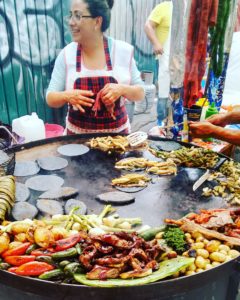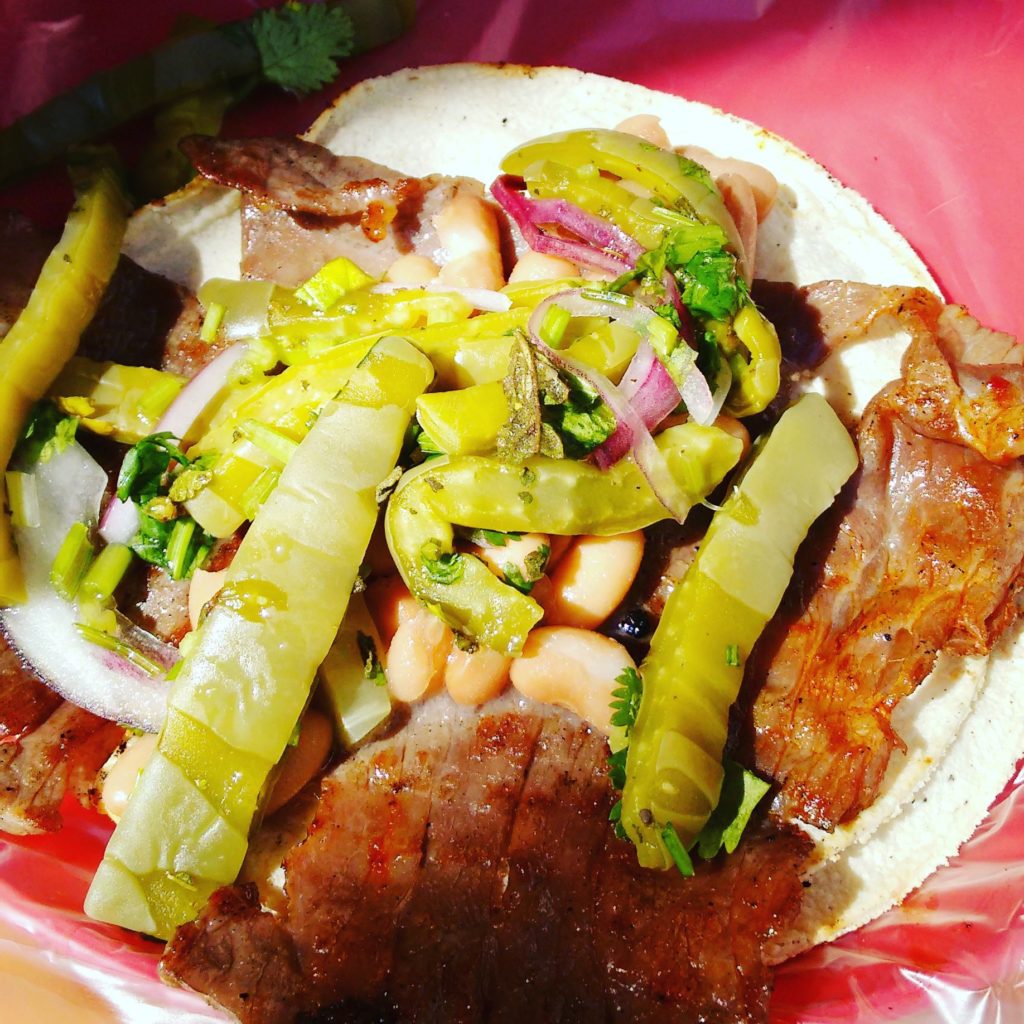With street food there are no hard and fast rules per se, but there are certain, let’s say, generalities that the nascent street food eater should know about before they hit the stands of Mexico City. Here are the telltale signs, the ingredient explanations and the no-rules “rules” of eating street food in Mexico’s capital.
Rules to Live By
Here are a few general things that I tell every person that asks me about Mexican street food:
- Eat at stands that look busy with locals, i.e. lots of turnover. Not only does it mean that they probably aren’t making people sick, but it also ensures the you get the freshest ingredients and preparation.
- There is no such thing as a salsa rule. Always ask for a little, “poquito,” to start out if you can’t do spicy — remember, you can always add more.
- I always feel better eating at a stand where the person cooking is not the one taking money, or alternatively, they at least take money with a plastic bag covering their hand — but I’m not a stickler if something looks amazing.
- There are times when people get mildly sick just by the sheer fact that they are eating unfamiliar items or lots of spice that they aren’t used to. The best way to approach street food as a non-resident is to go slowly, don’t eat at 5 different stands on your very first day in the city, ease into street food one bite at a time.

Speaking the Lingo
Let’s start out with some vocabulary:
Tacos – A broad category that includes anything folded into a tortilla — from grilled meats, to scrambled eggs to potatoes and sausage. In Mexico, food is “taco-ed,” and that means anything can become a taco at any moment.
potatoes and sausage. In Mexico, food is “taco-ed,” and that means anything can become a taco at any moment.
Tlacoyos – One of my favorite corn dough creations on the street, tlacoyos are cat-eye-shaped patties of dough where the raw dough has been wrapped around a filling of cheese (requesón which is a little like ricotta) or beans (either refried or mashed fava beans) and grilled until the outside is slightly browned and cooked and the inside filling is hot. They are generally topped with chopped raw onion and cilantro, cooked, cold nopal cactus, salsa (either red or green) and queso fresco, a harder grated cheese with a very mild taste.
Tlayudas – These large, crispy tortillas are made from a slightly different masa than regular tortillas, left to dry out a bit and refried with a bit of lard. They are generally topped with refried beans, cheese and a meat but can also have raw cabbage, roasted grasshoppers, fresh lettuce and cream. And always salsa. Find them on the street in Oaxaca.

Tortas – sandwiches on a slightly crispy bread roll, they have all kinds of fillings too, but generally include some kind of grilled meat (mostly likely a combination of a couple), quesillo cheese (that’s the stringy kind), avocado, lettuce, mayo, tomato, and something spicy — you can get chipotle peppers in a sauce usually or spicy, pickled veggies. Check out this guy manning a torta grill:
Huaraches – Long, thick, football-shaped tortillas that supposedly resemble the footprint of a huarache (a type of Mexican sandal). They are grilled on a flat grill and topped with a layer of beans, salsa and cheese, sometimes with the addition of bistec (thin beef steak) or cecina (dried, salted beef).
Sopes – Round like a tortilla but generally smaller, sopes are thick and when the dough is about half-cooked, their maker pinches the sides creating a little edge around the outside of the dough that keeps the filling in. Sopes are open-faced and can be topped with just about anything but usually have some combination of shredded meat, cheese, salsa, onion and cilantro on top.
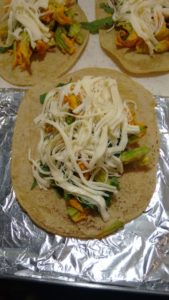
Quesadillas – In Mexico City, quesadillas are simply large, oval-shaped tacos with all kinds of different fillings inside, generally not only grilled meats like bistec or cecina but also rajas con crema (poblano peppers in a cream sauce) potatoes and sausage, chicken tinga (a shredded chicken in a mild tomato sauce) or beef tinga. If you want cheese all you gotta do is say “con queso,” with cheese is usually a few pesos more.
Gorditas – a type of very thick tortilla, the dough sometimes mixed with chicharron prensada, then deep-fried in pork lard. These are generally sliced into a little pocket, filled (filling type depends on where you are in the country) and then heated on the grill.
Tamales – Corn dough, ground slightly chunkier than tortilla dough, mixed with a little pork lard (a very few places use vegetable oil, sorry vegetarians), and then applied to the inside of a corn or banana husk. A smear of salsa then goes on top and and piece of meat or other addition (a slice of pepper or mushrooms, the list is endless). Then the husk is folded and tied and the tamales are steamed during which time the dough puffs up and encases the filling — delicious.
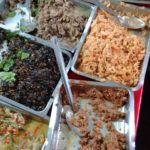
Barbacoa – Slow-roasted (the best is underground pit roasted) lamb or goat, generally served with a broth made from the meat’s drippings, other seasonings, garbanzo beans, and rice.
Birria – Pit-roasted or oven-roasted goat, lamb or beef, that is cooked with a variety of spices like clove, nutmeg, black pepper, garlic. It’s not spicy generally but very rich and flavorful and most often served with a broth like barbacoa. This dish is traditional to the state of Jalisco.
Rellenos (fillings) – These are what go in your tacos, most applicable with quesadillas
Masa (dough) – Pretty self-explanatory
Comal – The flat grill that you will find at most quesadilla/tlacoyo/gordita stands. Here is a photo:
How to Look Like You Know What’s Going On
No two street food stands are exactly the same, but telltale signs will let you know what kind of food they are serving almost immediately.
Tlacoyos & Quesadillas: Most tlacoyo stands sell quesadillas and vice versa. They are spottable normally as groups of 2-3 women, usually cooking around a small comal. One woman will be manning the comal with a trusty spatula, one making tortillas for quesadillas and tlacoyos either by patting them out by hand or using a tortilla press, and usually one woman is serving drinks and taking money. These stands are likely to be selling gorditas, but you can also find gorditas as the star of their own show at a stand or even as an added item in large stand selling other types of tacos.
Insider tip: Many tlacoyo/quesadilla/gordita stands in Mexico City use blue corn dough, it’s delicious, don’t let the color throw you off. If you happen upon obisipo quesadillas (a pork sausage from the State of Mexico) I beg you to try it.
Tacos: Generally, taco stands have a sign with a list of the types of tacos they offer, but you can also tell a few things without even needing to look. A convex grill with a little bump in the middle of it is used for slow cooking suadero (Mexico’s confit) and longaniza (sausage) in either fat or water. The meat is dredged up from the grease and set in the middle to drain a bit, then chopped and heated on the grill before it goes in your tortilla.
A large, flat grill means grilled meats like bistec, cecina and arrachera (a thicker flank steak) as well as any of those with grilled cheese (sometimes offered in a flour tortilla and sometimes not). Most of these stands also have an al pastor spit which you will recognize as a vertical skewer with layers of reddish, marinated pork meat on it.
While we are on the topic, tacos al pastor are reddish marinated meat on the spit and tacos arabes are displayed in the same format but with a regular meat color and spiced to a flavor that shares more in commmon with shwarma
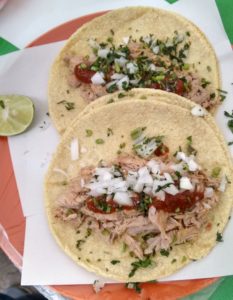
and is served in a pita. Both types of taco are more popular in the evenings than daytime.
You can find carnitas (deep-fried) pork any time of the day, but they are also most popular as a daytime taco. You will recognize them by the heat lamps keeping the cooked meat warm, generally inside a glass box so you can see
what you are ordering.
All of these meat-centric taco stands are generally run by either an entire crew of men or a mixed group of men and women, with men manning the grill and women serving, taking money, making tortillas, and cleaning up.
Insider Tip: Carnitas stands will ask you what part of the pig you want — maciza is a basic meat for beginners, but carnitas experts will tell you surtido (mixed meats) or particular appendage (cheek, snout, intestines) make you look much more like a badass when ordering.
Barbacoa: One of my favorite street foods, not only because I love barbacoa, but I also love the ambiance of the barbacoa stand. Barbacoa in Mexico City is a weekend affair and these stands set up long, family-style tables on Saturdays and Sundays along the city’s sidewalks. For most places it’s a family affair, with even the littlest members of the family washing dishes, taking orders and delivering food. Barbacoa is the ultimate hangover food in my opinion, but for many its gamey flavor is a turn-off.
These stands sell either goat or lamb barbacoa which is traditionally cooked in underground pits overnight, wrapped in maguey or banana leaves. These days not everyone is still making this dish in the old-fashioned way.
The meat is spreadable, butter tender and although served with all kinds of salsas, is best with a smoky chipotle. Barbacoa tacos also get a little raw onion and cilantro on top as well as a squeeze of lime, all self-serve instead of at other stands where taqueros will ask if you want verdura and put the cilantro and onion on for you.
Insider Tips: More high-end establishments buy younger (and therefore more expensive) animals and the gamey factor is less. The consommé (broth) is free with the order of tacos and most places have a regular and 1/2 size if you don’t want a full bowl. The broth makes a delicious dipping sauce for your tacos.
Tamales: Tamales are an early morning and early evening snack. Daytime vendors are generally stationary at tables and evening vendors mobile, usually on bikes. Two types of tamales can be found in Mexico City, those wrapped in corn husks, common to northern and central Mexico and Oaxacan tamales, wrapped in banana leaves. Their casings give each a distinctive flavor, but the consistency of their dough is also different, with corn husk tamales being fluffier and drier and Oaxacan tamales a little oilier and flatter.
Tamales can be both sweet and savory, with the most common fillings being pork with green sauce, mole with pork or chicken, rajas (poblano peppers), strawberry and pineapple. You will recognize tamale vendors by their large, round metal steamers with lids to keep the tamales nice and warm inside.
Most vendors also sell atole, which is a creamy corn drink served hot that can be flavored with chocolate, strawberry, rice milk or a million other things. A tamale and glass of atole make a very filling meal. Tamales vendors also sell tortas de tamal or tamal sandwichs, which just means an unwrapped tamal on a crusty bread roll, sometimes with a little of the inside bread torn out so it’s not overwhelmingly filling (but it’s still overwhelmingly filling).
Insider Tip: Tamales are no brunch food, if you’re not up and buying one before 10am you’re shit out of luck.
And… My Favorites
This post wouldn’t be complete without a list of some of my favorite street food stands. Because there are SO MANY to choose from, I couldn’t possibly mention them all, but here is a good list to get you started.
Grilled Tacos:
El Rey del Taco – Corner of Coahuila and Merida in Roma Sur
Los Parados – Corner of Monterrey and Baja California in Roma Sur
Suadero:
5 Hermanos – near door 11 at the Merced Market’s outer food hallway
El Negrito – the corner of Coahuila and Medellin in Roma
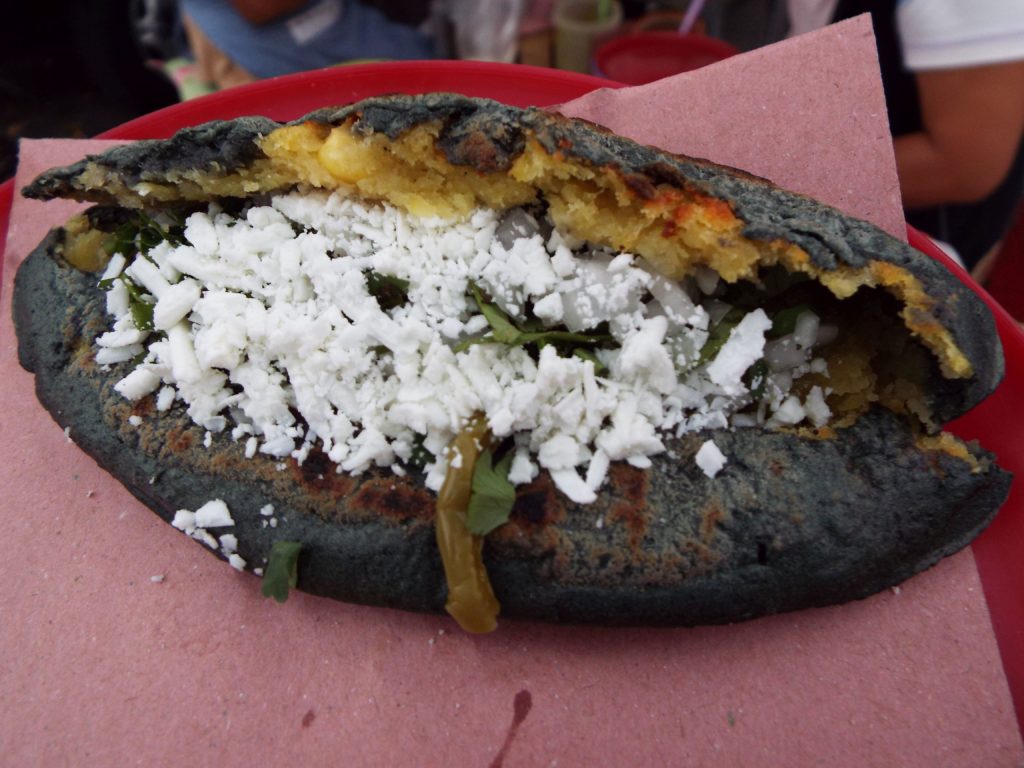
Tlacoyos/Quesadillas:
Mercado Medellin – There are two stands, one at each entrance, run by two different groups of women and both delicious, Campeche street between Monterrey and Medellin
El Comal Asesino – on the corner of Talxcala and Manzanillo in Roma
Quesadillas – Corner of Colima and Merida Roma Norte
Tamales:
Doña Emi – Jalapa 278, Roma Sur – I beg you to get the pork and olives (lomo y acietunas)
Vegan Tacos:
Paxil (plant-based seafood) – Orizaba street near Rio de Jainero in Colonia Roma
Malportaco – Diagonal San Antonio #1725, Narvarte
Barbacoa:
Barbacoa Renatos – Jacarandas 443, Azcapotzalco ** They might be closed now**
Weekend Stands
- Corner of Tonala and Campeche, they hand press their blue-corn tortillas
- Corner of Manzanillo and Campeche, this is the spot in the Roma for street barbacoa
Cochinita Pibil:
Sylvia’s – under the Pedestrian bridge all the way at the end, just past the Fuente de Petroleo in Las Lomas
El Turix – Calle Emilio Castelar 212, Polanco
Carnitas:
El Paisa – Tonala just down from the corner of Baja California, Roma Sur
Tacos La Reyna – Manzanillo 164-150, Roma Sur
Birria:
Birria Santa Barbara – Calle Bahia de Santa Barbara #39
Seafood tacos:
El Caguamo – Ayuntamiento street #18, Centro
Tacos al Pastor:
El Vilsito – Avenida Universidad, Colonia Narvarte
La Periquita – Antonio Caso #125, Colonia San Rafael
Want to take your very own STREET FOOD TOUR with yours truly? Check out my list of tours here and send me an email giving me some dates you will be ready to eat!!!
And Finally, a DISCLAIMER: There are about a million more things to know about street food. You’ll learn as you go.
Click here to subscribe via RSS


